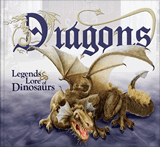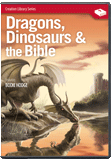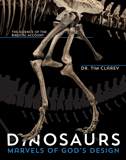
The Secret of the Mongolian Pterosaur
National Geographic News: “Pterosaur’s Wing, ‘Hairs’ Unlike Any Living Animals” What were pterosaurs really like? An uncertain topic grows all the more perplexing after a new look at an old fossil.
Paleontologists took a new look at Jeholopterus ninchengensis, a fossilized pterosaur discovered in Mongolia in 2000 along with crustacean fossils and ash. Facilitating the research is the fossil’s “remarkably well-preserved membranes.”
The duck-sized pterosaur has a membrane with a layer of structural fibers called actinofibrils, which are unique to pterosaurs.
And that brings us to our first point of interest: “It must have been rapidly buried after it died, perhaps by a river or maybe inside a lake[,] otherwise its soft tissue would have rotted away quickly and not been preserved,” explained study coauthor Alexander Kellner of Brazil’s National Museum. The evidence of rapid watery burial and volcanic activity all comports well with the Flood of Noah’s day and the corresponding volcanism.
As for the fossil itself, the duck-sized pterosaur has a membrane with a layer of structural fibers called actinofibrils, which are unique to pterosaurs. UV light revealed that the membrane had three or more layers of actinofibrils running in a crisscross pattern—a unique arrangement unlike any living animal.
The researchers have only unanswered questions about the makeup of the fibers and their purpose, though, as Kellner asked: “Were they muscle? Collagen? Keratin? Stiff? Elastic?” Regarding their purpose, Kellner suggested the fibers may have “made it easier to make subtle adjustments of the wing membrane when flying, perhaps giving them better flight capability,” or may have helped in the regulation of body temperature. The fibers are “much more complex than we thought,” Kellner concluded.
The new J. ninchengensis research feeds into other unanswered questions about the true nature of extinct reptiles. Some have suggested such fibers are not fibers at all, but rather the remains of tissue decay during fossilization. Likewise, some dinosaur fossils have given rise to speculation about “feathered dinosaurs,” which in turn has fed the notion that some dinosaurs evolved into birds. (National Geographic News even offers a “related link” to an older news report, “Feathered” Dinosaur Was Bald, Not Bird Ancestor, Controversial Study Says.)
The Bible nowhere precludes the possibility of dinosaurs or pterosaurs with feathers, and for that reason, we cannot be dogmatic on the issue. Still, most of us find the evidence for feathered dinosaurs quite lacking and driven by evolutionary needs (i.e., an origin for birds) rather than the raw facts. J. ninchengensis shows that God uniquely designed pterosaurs for their functions (such as flying) and their environment.
For more information:
Remember, if you see a news story that might merit some attention, let us know about it! (Note: if the story originates from the Associated Press, Fox News, MSNBC, the New York Times, or another major national media outlet, we will most likely have already heard about it.) And thanks to all of our readers who have submitted great news tips to us.
(Please note that links will take you directly to the source. Answers in Genesis is not responsible for content on the websites to which we refer. For more information, please see our Privacy Policy.)
Recommended Resources

Answers in Genesis is an apologetics ministry, dedicated to helping Christians defend their faith and proclaim the good news of Jesus Christ.
- Customer Service 800.778.3390
- © 2024 Answers in Genesis





